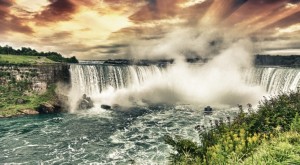 Every fantastic place needs a fantastic origin story. Indigenous groups all over the world have extraordinary mythologies explaining the creation of a region’s landmarks, the existence of the moon and stars, the birth of humankind, and more. Niagara Falls is no different; ever since the first Native Americans set eyes on the unbelievable intensity and beauty of the Falls, people have been telling stories about how they became what they are today. However, while traditional stories may involve gods and magic, the truth behind Niagara Falls’ creation is just as amazing. Learn more about the origin of the region so when you visit Niagara Falls this year you’ll fully comprehend their majesty and power.
Every fantastic place needs a fantastic origin story. Indigenous groups all over the world have extraordinary mythologies explaining the creation of a region’s landmarks, the existence of the moon and stars, the birth of humankind, and more. Niagara Falls is no different; ever since the first Native Americans set eyes on the unbelievable intensity and beauty of the Falls, people have been telling stories about how they became what they are today. However, while traditional stories may involve gods and magic, the truth behind Niagara Falls’ creation is just as amazing. Learn more about the origin of the region so when you visit Niagara Falls this year you’ll fully comprehend their majesty and power.
Precambrian Niagara
More than 600 million years ago, the area we recognize as the Great Lakes region, including Niagara, was buried beneath a vast, shallow sea. For more than 100 million years, the forces of nature churned the waters of this North American sea until the hard rocks below became fine, soft sediment resting on top of hard bedrock. The sea held all types of life, including vast tropical reefs filled with fish, but the violent commotion of waves caused by storms often destroyed the beautiful marine communities and left their limestone skeletons at the bottom of the waters.
During this time, the rest of the North American continent underwent extreme topographical shifts. The Appalachian Mountains shot up out of the ground, new rivers wound their way around the landscape, and different types of geology appeared all over.
Phanerozoic Niagara

Meanwhile, the landmass migrated farther and farther northward, so temperatures dropped and the environment changed. In quick succession, four major ice ages cut into the continent, their glaciers leaving huge scars upon the landscape. The final ice age, at its peak around 25,000 years ago, was particularly rough on the Niagara region, as the Wisconsin glaciation covered most of Canada in dense ice more than a mile thick. This ice mercilessly crushed everything in its path, from forests to mountains.
Then, roughly 12,000 years later, the glacier reversed its movement. Melt from the retreating glacier was channeled through the deep cuts carved in the earth, and the rivers we recognize today — the Hudson, the Ohio, and the great Niagara — were formed.
Eventually, the last ice age ended and the water levels dropped, revealing the freshly cut Niagara Escarpment. Originally, the Niagara River appeared to be a series of massive lakes spilling into one another. Indeed, Lake Erie fell from the top of the escarpment into the small Lake Tanawanda, which in turn spilled into Lake Iroquois. However, as the water tapered off, the ancient lakes took the shape of a river, and the spillways transformed into Niagara Falls.
Niagara Falls has been in formation for thousands and thousands of years, and the landscape continues to change and move with complete disregard to the majesty and wonder it currently inspires. In fact, the
Falls themselves are working to fundamentally alter the scenery, as the rushing waters carve inches off the escarpment every year. Still, all humankind can do is sit back and take note of the incredible power and beauty of nature.
